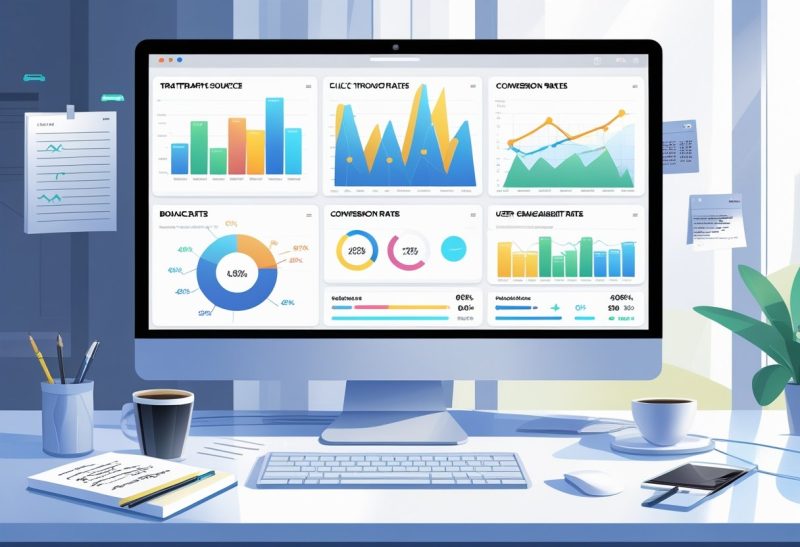When it comes to optimizing your online presence, tracking keyword rankings is just the beginning. You should also focus on metrics like organic traffic, bounce rate, and conversion rate to gain a comprehensive view of your website’s performance. This insight allows you to refine your strategies and make informed decisions.
Utilizing tools like Serpple can help you manage multiple clients efficiently, providing you with valuable data without incurring high costs associated with premium tools. By monitoring additional metrics, you can understand what drives user engagement and where improvements can be made.
Expanding your focus beyond just rankings enables you to identify trends and areas for growth. By keeping an eye on the right metrics, you can enhance your overall digital marketing strategy and achieve better results.
Understanding Key SEO Metrics Beyond Rankings
To optimize your SEO strategy, it’s essential to monitor metrics beyond just keyword rankings. Various key performance indicators can offer deeper insights into user behavior and overall SEO performance. Utilizing tools like Serpple makes it easier and more affordable to track these metrics effectively.
The Importance of Key Performance Indicators
Key performance indicators (KPIs) are crucial for evaluating the effectiveness of your SEO efforts. While rankings provide a snapshot of visibility, KPIs offer a broader view of success.
- Organic Traffic: This measures the number of visitors coming to your site from search engines. Higher organic traffic indicates successful SEO strategies.
- Conversion Rate: This reflects the percentage of visitors who complete desired actions, such as making a purchase or signing up for a newsletter. A high conversion rate indicates effective targeting and content.
- Backlink Quality: Monitoring the quality and number of backlinks helps assess your site’s authority. Quality backlinks from reputable sites can significantly enhance your SEO performance.
User Behavior and Experience Metrics
Understanding user behavior is vital for improving customer experience on your site. Metrics in this category help you recognize how visitors interact with your content.
- Bounce Rate: A high bounce rate indicates that visitors are leaving your site quickly. Analyze pages with high bounce rates to identify and fix issues.
- Average Session Duration: This metric shows how long users stay on your site. Longer sessions often suggest that users find your content engaging.
- Click-Through Rate (CTR): This measures the percentage of users who click on your link compared to those who view it in search results. A high CTR often reflects well-written titles and snippets.
Assessing SEO Performance Holistically
A holistic approach to SEO means integrating various metrics for a complete view of your website’s performance. Consider these elements.
- Core Web Vitals: These metrics evaluate loading performance, interactivity, and visual stability. Improving these factors enhances user satisfaction.
- Customer Feedback: Gathering insights directly from users helps identify issues affecting customer experience. Use surveys or feedback forms to collect valuable information.
- Engagement Metrics: Analyzing metrics like page views and social shares can reveal how content resonates with your audience. Use this data to refine your strategy.
By focusing on these key areas, you can gain a more comprehensive understanding of your SEO performance and enhance your website’s effectiveness in meeting user needs.
Traffic Quality and Engagement Signals
Monitoring traffic quality and engagement signals is critical for understanding how well your content resonates with users. Instead of focusing solely on rankings, evaluating these metrics can provide deeper insights into user behavior and content performance. Utilizing tools like Serpple allows you to track these essential metrics affordably, helping you manage multiple clients more efficiently.
Organic Traffic Analysis
Organic traffic refers to visitors who arrive at your site through unpaid search results. Analyzing this traffic provides insight into which keywords successfully attract users and how valuable that traffic is.
To assess organic traffic, consider metrics such as total visits and specific landing page performance. High organic traffic levels suggest that your SEO strategies are effective. However, it’s essential to look beyond quantity; examine the quality of traffic. Are visitors spending time on your site and engaging with your content? Tools like Google Analytics can help track bounce rates and user flows to identify areas for improvement.
Impressions and Clicks
Impressions represent the number of times your site appears in search results, while clicks indicate how many users selected your link. Monitoring both metrics helps gauge your content’s visibility and effectiveness.
You can analyze these numbers to understand how well your titles and meta descriptions are capturing user interest. A high number of impressions coupled with low clicks may signal that your snippet isn’t enticing enough, prompting a review of your SEO elements. Tools like Serpple can efficiently track both impressions and clicks, allowing you to adapt your strategies quickly.
Click-Through Rate (CTR)
Click-through rate (CTR) measures the percentage of impressions that result in clicks. It’s a vital engagement metric that reflects the effectiveness of your search results.
A higher CTR suggests that your title tags and meta descriptions are working well to attract clicks. To calculate CTR, use the formula: (Clicks / Impressions) x 100. If your CTR is low, consider tweaking your headlines or improving your content’s relevance to the intended audience. Monitoring CTR over time allows for performance comparisons and strategic adjustments, critical for maximizing engagement and enhancing content visibility.
Focusing on these metrics gives you a clearer understanding of how users interact with your content, ultimately leading to improved performance and achieving your SEO goals.
Conversion-Oriented Performance Metrics
Monitoring various conversion-oriented performance metrics is essential for optimizing your marketing strategy. Understanding how your efforts translate into tangible results can significantly impact your business growth. Utilizing tools like Serpple can help you track these crucial metrics without incurring high costs.
Conversion Rate Monitoring
The conversion rate is a key performance indicator that directly reflects your website’s effectiveness in turning visitors into customers. To calculate your conversion rate, divide the number of conversions by the total number of visitors, then multiply by 100 to get a percentage.
For example:
- Conversions: 50
- Total Visitors: 1,000
- Conversion Rate: (50/1000) * 100 = 5%
Regularly monitoring your conversion rate allows you to identify trends and make data-informed adjustments. This includes optimizing landing pages, refining calls to action, and improving overall user experience. A/B testing different elements can also yield valuable insights.
Lead Generation Tracking
Tracking lead generation metrics helps you evaluate how many potential customers engage with your brand. Focus on key metrics such as the number of leads generated, cost per lead, and conversion rates of those leads.
To break it down:
- Number of Leads: Monitor how many leads are coming from various channels.
- Cost Per Lead (CPL): Calculate this by dividing your total marketing spend by the number of leads generated.
Understanding these metrics enables you to refine your targeting strategies and allocate your budget efficiently. Aim to enhance lead quality while minimizing costs, ensuring you’re nurturing leads that are more likely to convert.
Return on Investment (ROI) Evaluation
Measuring ROI provides insight into the profitability of your marketing efforts. To calculate ROI, subtract the cost of your marketing initiatives from the revenue generated, then divide this number by the total cost. The formula looks like this:
ROI = (Revenue – Cost) / Cost x 100
For example, if your campaign cost $1,000 and generated $5,000 in revenue, your ROI would be:
ROI = (5000 – 1000) / 1000 x 100 = 400%
Evaluating ROI helps you identify which strategies yield the best results. Focus your resources on higher-performing campaigns while assessing underperforming areas for improvement. By doing so, you can maximize your overall marketing effectiveness.
Technical and Operational Metrics
Monitoring technical and operational metrics is crucial for optimizing website performance and enhancing user experience. You should focus on specific areas like response times and resource utilization to ensure your site runs smoothly and efficiently. Utilizing tools such as Serpple can help you track these essential metrics without incurring high costs.
Response Times and Website Speed
Response times significantly impact user satisfaction and engagement. Ideally, your website should load within three seconds, as longer wait times lead to higher bounce rates. You can use various tools to assess response times, including Google PageSpeed Insights and GTmetrix. These tools provide detailed insights on load times, enabling you to identify bottlenecks.
Factors influencing response times include server performance, network latency, and webpage complexity. Regularly testing these elements can help you pinpoint areas needing improvement. You might want to prioritize optimizing images, leveraging browser caching, and minimizing HTTP requests. Maintaining server health is also paramount, which involves monitoring uptime and regular maintenance.
Resource Utilization Metrics
Resource utilization metrics help you monitor how effectively your website’s resources are deployed. Key indicators include CPU usage, memory usage, and disk I/O. High resource consumption can indicate issues such as inefficient code or high traffic loads requiring scaling solutions.
Utilizing tools like Serpple can streamline this tracking, offering insights into resource performance without the expense of premium options. Keeping an eye on these metrics allows you to allocate resources effectively and address potential issues proactively. Aim for balanced resource usage to maintain optimal site performance, ensuring an efficient user experience. Regular analysis of these metrics enhances your site’s reliability and speed.
Off-Page and Strategic SEO Indicators
In addition to monitoring rankings, it’s essential to examine off-page elements and your overall SEO strategy. Focusing on your backlink profile, analyzing referral sources, and refining your content strategy can provide valuable insights into your website’s performance.
Backlink Profile Assessment
Your backlink profile is crucial for your site’s authority and visibility. Start by auditing both the number and quality of backlinks pointing to your site. High-quality backlinks from reputable sources are more valuable than numerous low-quality links.
Utilize tools like Serpple to manage backlink tracking efficiently. They can help identify toxic links that may harm your site’s reputation. Regularly monitoring anchor text variations allows you to optimize your outreach efforts, ensuring a diverse backlink portfolio.
Referral Source Analysis
Understanding where your traffic is coming from can inform your marketing decisions. Analyze referral sources to pinpoint which domains are driving the most traffic to your site. This data helps in identifying potential partnerships or guest blogging opportunities.
Utilize analytics tools to track referral metrics. Look for trends in traffic patterns from specific sources and tailor your marketing efforts accordingly. Focusing on high-traffic referral sources can enhance your reach and build credibility within your niche.
Content Strategy and Scheduling
A well-organized content strategy is key to maintaining engagement. Plan your content around audience needs and industry trends. Use a content calendar to schedule posts, ensuring a consistent publishing routine.
Monitor the performance of your content regularly. Identify which topics resonate the most with your audience and adjust your strategy based on engagement metrics. High-quality, relevant content not only boosts SEO but also builds trust with your audience.
Incorporate your findings into a broader strategy. Adjust your scheduling based on peak engagement times to maximize reach. Focus on providing value, and your audience will reward you with greater traffic and loyalty.
Customer Perception and Business Alignment
Understanding customer perception is vital for aligning your business objectives with customer expectations. Metrics such as Net Promoter Score (NPS), schedule variance, budget variance, and cycle time provide valuable insights into how well your business meets its goals and customer needs. By monitoring these metrics, you can enhance your decision-making and improve overall performance.
Net Promoter Score (NPS)
Net Promoter Score is a widely used metric to gauge customer loyalty. By surveying your customers, you can categorize them into promoters, passives, and detractors based on their likelihood to recommend your service.
To calculate NPS:
- Ask customers how likely they are to recommend your business on a scale from 0 to 10.
- Subtract the percentage of detractors (scores 0-6) from the percentage of promoters (scores 9-10).
This score helps you identify areas needing improvement and customer segments that are particularly loyal. Regularly tracking NPS can inform your strategies and enhance customer satisfaction.
Schedule Variance and Budget Variance
Schedule variance measures the difference between the planned completion of tasks and the actual completion dates. Monitoring this allows you to identify delays that may hinder customer satisfaction.
Budget variance, on the other hand, tracks the difference between the budgeted amount and the actual expenditures. If there’s a significant disparity, it may indicate inefficiencies that could affect your ability to serve customers effectively.
Both metrics help you assess operational efficiency, enabling you to align your resources with changing customer demands. Analyzing these variances gives you actionable insights into where adjustments are necessary.
Cycle Time Measurement
Cycle time measures the total time from the beginning to the end of a process. For your business, this might include customer ordering to delivery.
Shorter cycle times often lead to higher customer satisfaction, as they reflect efficiency and responsiveness. Tracking this metric helps identify bottlenecks within your operations.
To optimize cycle time:
- Break down processes into smaller tasks.
- Regularly review and refine them.
Improving cycle time can significantly enhance customer experience and strengthen business alignment with their expectations.
By focusing on these key metrics, you can gain a more comprehensive view of how well you’re meeting your customers’ needs and ensuring organizational effectiveness.
Frequently Asked Questions
Understanding which metrics to monitor can significantly enhance your decision-making process. By focusing on specific performance indicators, you can gain valuable insights across various domains, ensuring efficient management and evaluation of your business activities.
What are the essential performance metrics for measuring employee effectiveness?
Key performance metrics for employees include productivity rates, quality of work, and attendance. Tracking these metrics can provide insight into individual contributions and help identify training or support needs.
Which key success metrics are critical for evaluating a project’s outcomes?
Important success metrics for project evaluation include return on investment (ROI), project completion time, and stakeholder satisfaction. These indicators help assess whether project goals were achieved and if resources were used efficiently.
What are the four main types of performance indicators businesses should track?
Businesses should track financial performance indicators, customer satisfaction metrics, operational efficiency measures, and employee performance indicators. Each category offers unique insights that can inform strategic decisions.
How do you determine the right metrics to monitor for application performance?
To determine the right metrics for application performance, consider your specific goals. Metrics such as response time, error rate, and user engagement will directly impact overall application efficiency and user satisfaction.
What metrics are indicative of a successful product lifecycle?
Successful product lifecycle metrics include sales growth, customer retention rates, and market penetration. Monitoring these metrics can help identify trends and provide direction for future product improvements.
Can you list major performance metrics across different business domains?
Major performance metrics vary by domain but commonly include sales revenue, net promoter score (NPS), operational costs, and employee turnover rates. Each metric serves as a cornerstone for measuring effectiveness in its respective area.


